|
Preliminary remark: The “Light Conditions” Project The following text was written within the framework of a large-scale project on “Light in Early Modern Times”. Within that context, it soon became clear that the endeavour to say something about light in past epochs must take the complexity of the circumstances into account. To borrow Althusser’s concept of “overdetermination”, it can be argued that every light situation (at least every earthly one) is multiply “overexposed”; it comprises layer upon layer of the most heterogeneous definitions and meanings: the physical attributes of light in their historically differing descriptions, the methods of light’s technical production and recognizability, the interplay between scientific and commonplace knowledge about light, the simultaneous assignment of mythical, religious and philosophical meaning, the history of conventions for depicting light, its embedment in cultic practices, its role in the history of sensory perception, physical sensation, etc. The historical analysis of light, in other words, is always confronted with “mixed light” – a reality assembled from widely heterogeneous elements, and one in which physical and metaphysical, technical and cultural, aesthetic and political conditions are inextricably intertwined. The inevitable circumstance that light conditions can always only be analyzed as mixed conditions is what accounts, first of all, for the project’s interdisciplinary approach. In order to describe light situations, it is necessary to involve a wide range of disciplines, and not to shy away from crossing the great threshold separating the humanities from the natural sciences. Secondly, the interlinked conditions dictate small-scale depiction. In order to advance beyond the mere level of general remarks on the light of an epoch or a geographical region, the investigation concentrates on individual, temporally and spatially limited light situations, brief episodes and local light sceneries. The “history of a spot of light” recounted in the following is accordingly conceived as an exercise in a “local history of light”.
|
|||||||||||||||||||||||||||||||||||||||||||||||||||
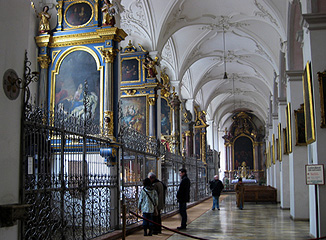 |
|||||||||||||||||||||||||||||||||||||||||||||||||||
|
Munich, Parish Church of St Peter, northern aisle |
|||||||||||||||||||||||||||||||||||||||||||||||||||
|
The following deliberations revolve around an event which came to pass in Munich’s oldest parish church, St Peter’s, on 28 April 1783. To borrow a term popular at the time, it can be regarded an “Eräugnis” – a combination of “Ereignis” (“occurrence”) and “Auge” (“eye”), and thus “a thing that happens to the eye”.
|
|||||||||||||||||||||||||||||||||||||||||||||||||||
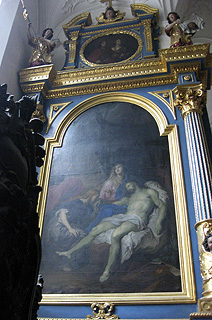 |
|||||||||||||||||||||||||||||||||||||||||||||||||||
|
Johann de Pay: The Lamentation of Christ (copy after Anton van Dyck), oil on canvas, ca. 1740, Munich, Church of St Peter |
|||||||||||||||||||||||||||||||||||||||||||||||||||
|
On the morning of this 28 April, a Monday described as being bright and sunny, the pious maidservant of a butcher “very devoutly” attended the holy sacrifice of the mass offered at the Altar of St Qurinus in a side chapel of St Peter’s. “With clasped hands”, she raised “her brine-filled eyes” to ”the sorrowful […] Mother Mary”, whose likeness decorated the chapel, and “beheld a wonder: all of a sudden she became aware that this likeness of the acquiescent and sorrowful Mary was turning its eyes.”[1]. At the first sight of this wonder, the maidservant was so afraid that she nearly turned pale. […] She went out of the chapel and told the people kneeling here and there in the church what she had seen, and they hurried in droves to the chapel to behold the likeness of the Virgin. [And] nearly every one of both sexes could see, with open eyes, the painted image of the Virgin moving her eyes and look sadly back and forth.[2] The fact that this miracle took place during the Age of the Enlightenment was not reflected in the behaviour of the believers – who flocked to the scene just as they had always done before ‒, but in that of the clergy, who found the matter unpleasant. And the latter group therefore availed themselves of a trick they keep up their sleeves for such cases, namely the removal of the object of devout desire from view under a pretext. At the behest of the bishop, the likeness was “draped with the curtain customary during Lent” – a solution which naturally, and as might be expected, only heightened the “zeal of the people”.[3] Every day, an “unbelievable crowd” made its way before even the “veiled likeness”.[4] |
|||||||||||||||||||||||||||||||||||||||||||||||||||
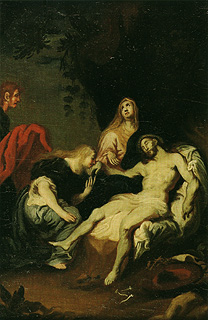 |
|||||||||||||||||||||||||||||||||||||||||||||||||||
|
Anonymous: The Lamentation of Christ (copy after Johann de Pay), oil on canvas, ca. 1783, Münchner Stadtmuseum |
|||||||||||||||||||||||||||||||||||||||||||||||||||
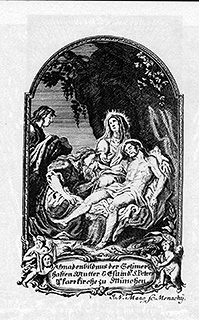 |
|||||||||||||||||||||||||||||||||||||||||||||||||||
|
Miraculous Portrait of the Sorrowful Mother of Jesus, engraving by J. N. Maag, ca. 1783, Münchner Stadtmuseum |
|||||||||||||||||||||||||||||||||||||||||||||||||||
|
At the same time, the withdrawal of the object from view also promoted its reproduction. Whereas the painting itself disappeared behind a curtain, an abundance of “after-images” turned up to replace it. In addition to the painted copy, the Münchner Stadtmuseum today has in its possession 133 different engraved variations of the altarpiece, all of them executed entirely under the spell of the miracle, and many of them presumably before a closed curtain, from memory or fantasy.[5] |
|||||||||||||||||||||||||||||||||||||||||||||||||||
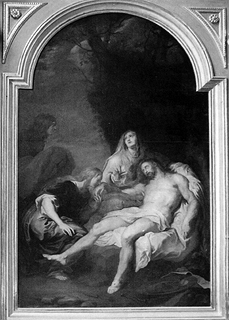 |
|||||||||||||||||||||||||||||||||||||||||||||||||||
|
Johann de Pay: The Lamentation of Christ (copy after Anton van Dyck), oil on canvas, ca. 1740, Munich, Church of St Peter |
|||||||||||||||||||||||||||||||||||||||||||||||||||
|
Today, the painting in question can be examined without having first to lift the curtain. It is a copy of a Lamentation of Christ by Anthony van Dyck6 executed in the mid-seventeenth century by Johann de Pay, a court painter to the elector.7 Until the day of its bewitchment, the painting led a tranquil existence in a side chapel of St Peter’s. It was, however, among the city’s sights, and travellers and “admirers of the fine arts” accordingly did not neglect to honour it with a visit: The dead corpse of Christ on the lap of his aggrieved mother who in her distress looks heavenward; the beloved discipless Magdalene kisses the stiff hand; St John opposite, holds the robes of death in his arms.”[8] |
|||||||||||||||||||||||||||||||||||||||||||||||||||
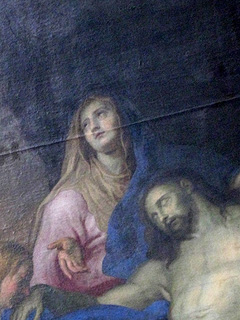 |
|||||||||||||||||||||||||||||||||||||||||||||||||||
|
Johann de Pay: The Lamentation of Christ (detail) |
|||||||||||||||||||||||||||||||||||||||||||||||||||
| On said day in April, this image of death strangely awakened to life. The Virgin’s eyes began to turn, and their movements seem to be reinforced and accelerated the larger the crowd. To the maidservant it looked as though the portrait began “to lift [its gaze] quite distinctly and slowly, and then to lower it again immediately”.[9] In the perception of subsequent onlookers, Mary not only directed her gaze “entirely above herself, towards heaven”,“[10] but also towards the attendant folk. And those who came even later asserted that “Mary’s eyes”[11] turned “with almost complete loss of the eye’s black globe”, [12] only to snap back to their previous position again immediately afterwards.
The light striking the sorrowful Virgin and her admirers on the morning of 28 April 1783 can no longer be reconstructed. Although the painting is still in the church, it did not remain in its original place – in a double sense. It was moved to a different chapel, and what is more, the entire building, even if it is the same, is no longer the same. |
|||||||||||||||||||||||||||||||||||||||||||||||||||
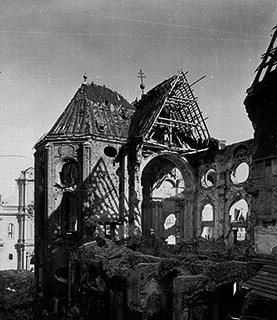 |
|||||||||||||||||||||||||||||||||||||||||||||||||||
|
Munich, Church of Peter, the north wall of the nave in ruins, photograph of 1946 |
|||||||||||||||||||||||||||||||||||||||||||||||||||
|
It can be said, however, that – despite its Romanesque and Gothic origins – in the eighteenth century the Church of St Peter represented a Baroque, or more precisely a Rococo-style, church, at least in its interior. |
|||||||||||||||||||||||||||||||||||||||||||||||||||
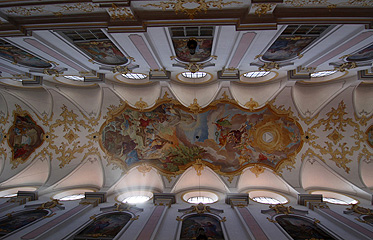 |
|||||||||||||||||||||||||||||||||||||||||||||||||||
|
Munich, Church of St Peter, ceiling of the centre aisle |
|||||||||||||||||||||||||||||||||||||||||||||||||||
|
The high altarpiece is the work of the Asam brothers, the stucco that of Johann Baptist Zimmermann, and the windows, in their entirety, can also be traced back to the building’s conversion to the Baroque style.[13] Thus if there is anything that can be called “Baroque light”, it must have prevailed in the Church of St Peter in the year 1783, particularly on a bright April day. But what does the light have to do with the turning of the eyes? The “impartial” analysis of the miracle by the enlightened secular Ignaz Schmid provides us with an initial clue. He remarked that the composition had been painted “very well and with a great deal of sensitivity”.[14] |
|||||||||||||||||||||||||||||||||||||||||||||||||||
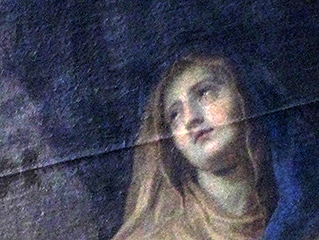 |
|||||||||||||||||||||||||||||||||||||||||||||||||||
|
Johann de Pay: The Lamentation of Christ (detail) |
|||||||||||||||||||||||||||||||||||||||||||||||||||
|
Particularly the left eye […] is very deceptive. The white in the eye, which is lowered so demurely and naturally, is delusive, and you really think it is following you everywhere, no matter where you go.[15] So, oddly enough, it is not the Madonna’s pupil which seems to be looking at the viewer wherever he is; for as the eyewitnesses describe, the pupil is turned upward. It is, on the contrary, the “white in the eye” which accounts for the impression of a gaze – a gaze moreover described as “delusive”. Schmid goes on to describe this prominence of the gaze, which he says is “certainly not a miracle, but rather nature, which the painter has borne to the canvas with a bold, creative hand”.[16] Yet despite Schmid’s obvious efforts to put the whole matter back on familiar territory, the concern here is not simply with an eye that is so naturalistically rendered as to resemble a real eye. The act of transference which the artist achieved here, rather, appears to consist in the natural eye’s turning into something other than an eye, namely a look. Already Heinrich Wölfflin recognized this achievement as the special quality of Baroque portrait painting: In a sense different from that of the classical portrait, it is necessary to say of the Baroque portrait that its content is not the eye but the look.[17] As Sartre described in a famous passage in Being and Nothingness, the relationship between the eye and the look is to be conceived of as one of mutual exclusion: On the contrary, far from perceiving the look on the objects which manifest it, my apprehension of a look turned toward me appears on the ground of the destruction of the eyes which ‘look at me’. If I apprehend the look, I cease to perceive the eyes […].[18] The psychoanalyst Jacques Lacan was particularly interested in the optical foundation of this “triumph of the gaze over the eye”[19]; he describes it as a “deception of the eye” in which the inundation of light destroys the geometric, linear capacity of representation. Rather than remaining at a perspectival distance, the objects close in on the viewer or, as Lacan puts it, “Les choses me regardent.” – “The things regard me.”[20] The secular priest Schmid, who noticed the captivating power of the white spot in the eye of the Virgin, did not neglect to relate that power to the power of light. Intuiting some kind of wave theory, he described light as “an agile being”,[21] which sets the straight lines of geometric optics in motion and undermines the geometric order: If I fix my eye on an object sharply for a long while, the suspended light rays have an ever greater effect […] on my eye, […] and precisely for that reason, the vibration between my eye and the point I am looking at appears as a change or shift of that point itself.”[22] Of decisive importance here is that the spot in question – namely the white in the Virgin Mary’s eye, is no longer a point in the geometric sense but – to borrow Lacan’s terminology – a “point lumineux”, a luminous point, defined not by the intersection of two lines, but by the “irradiation, the play of light”.[23] If the geometric order of sight is founded in the possibility of making a point (whether an eyepoint, a vanishing point or a point in a picture), the spot of light signifies the destabilization of that order and the insistence on a different kind of perception which demands to be referred to as an incarnation rather than a representation. The spot is virtually light’s born vehicle, precisely that element of the painting which breaks through the representational function and responds to being looked at with looking itself. The painting, Lacan says, “regards me on the level of the spot of light, where everything that regards me is to be found”.[24] It is the spot in the painting from which the light returns the gaze, becomes engrossed in the subjects’ bodies and draws/marks them with light (“photo-graphs”[25] them, to quote Lacan’s play on words).
In a painting it is thus the reflections and overexposures, the effects of shining, shimmering and glowing which threaten the predominance of the representation, making it teeter on the brink of becoming a gaze as fascinating as it is frightening.[26] Unlike the reflections in mirrors, which obey the laws of Euclidean geometry, the light reflections and shiny effects which can become vehicles of gazes are neither identically reproducible nor predictable. The “the point of gaze [point de regard] always participates in the ambiguity of the jewel”.[27] Thus it was the phenomena of light, of all things, which took a final stand against the Enlightenment. To a new way of thinking which was just in the process of “treating every existing thing in such a way that the reckoning human being can be sure of that existing thing”,[28] an unpredictable incidence of light must have seemed just as loathsome as the related possibility of a “rendezvous with the real”.[29]The mission of the Enlightenment would accordingly consist in attacking that final stronghold of the miraculous and getting light back on the straight and narrow. “This making secure”, as one could add by quoting Heidegger, would “be a calculating, for calculability alone guarantees being certain in advance, and firmly and constantly, of that which is to be represented”.[30] It was a certain Johann Nepomuck Fischer, doctor of theology, professor of pure mathematics in Ingolstadt and astronomer at the observatory there, who took on this task of calculation with regard to the miracle of 1783. Dismissed from university service in 1781 for being a Jesuit, he lived in Munich on a modest pension and did what he could to avoid oblivion by publishing occasional papers on a wide range of subjects.[31] Among his scientific activities, which have been characterized as “inconsistent”, [32] his research on optics is conspicuous. In 1779 he had been honoured with the prize of the Göttinger Gesellschaft der Wissenschaften (Göttingen Association of Sciences) for his work on the diffraction of light. Lichtenberg expressed himself very favourably on that paper, which Fischer had prefixed with the proud motto “Hanc ego de tenebris lucem” – “This light I [bring] over the darkness”. |
|||||||||||||||||||||||||||||||||||||||||||||||||||
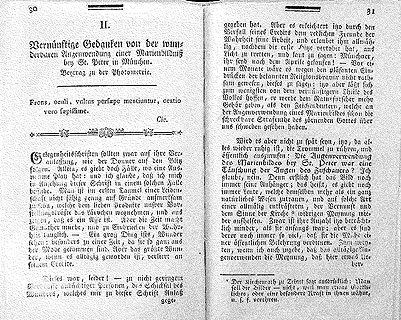 |
|||||||||||||||||||||||||||||||||||||||||||||||||||
|
Anonymous [Johann Nepomuck Fischer]: Vernünftige Gedanken von der wunderbaren Augenwendung, Munich, 1783. |
|||||||||||||||||||||||||||||||||||||||||||||||||||
|
In similarly self-confident manner, Fischer addressed himself to the painting in the Munich Church of St Peter in 1783, which he would subject to thorough analysis: However little a friend of crowds I am, after several days I nevertheless ventured to join the throng, not to see miracles as well, but to see that which I could presume others had overlooked. – I came, I saw, I discovered what I had suspected.[33] Fischer did not dwell on the psychological discredit of a perception flooded by fantasy. For him it was a matter of deducing the mechanism of deception from the conditions of the “light and the eye”. From now on, no longer theology was to be in charge of images of the Virgin Mary rolling her eyes, but the “science of sight”.[34] With the help of that science, Fischer promised, he would gain control over the “miraculous phenomenon in the same way the puppeteer controls the limbs of his puppets”.[35] Drawing from Johann Heinrich Lambert’s theory of light measurement or “photometry”[36] – to be discussed shortly – Fischer undertook experiments of his own to find evidence of how colour surfaces of different brightness appear different in size. Fischer attributed this effect to the peculiar structure of the retina, on which the “image, rather than consisting of dots of light is composed of small circles of light”.[37] Owing to the fact that the sensation of light “on the retina” reaches beyond “the area which it occupies on the same”,[38] the brighter section of an image can reduce a neighbouring dark section in size, or – if it is “very brilliant” – even “conceal it entirely”.[39] The spot of light in the eye of the Madonna was evidently “brilliant” enough to create such an effect, all the more so in view of the fact that the painting had just come back from the “master hand” of court painter Oefele “who had had it in his house for the purpose of brightening it up”.[40] With calculable certainty, the contrast between the white and the black in the eye of the Virgin (made all the stronger by Oefele’s restoration measures) brings about the effect of overexposure and thus, for anyone who is susceptible to it, the subjective impression of a rolling of the eyes – and the miracle is explained.
The “Munich Eye-Rolling” of 1783 – that minor event on the periphery of enlightened Europe – provides evidence that the “break” with the camera obscura model of sight which Jonathan Crary associates with the period around 1800[41] will have to be dated somewhat earlier. Yet just as geometric optics entered a state of crisis, there was someone already working on rescuing it. The mathematician and physicist Johann Heinrich Lambert, whose works Fischer took as the basis for his analysis, tackled the problems of the camera obscura from two angles – by expanding the theory of perspective on the one hand, and by making the impression of light accessible to mathematical calculation on the other. With the “free perspective”[42] he proposed in 1759, perspectival projection became a simple and mechanizable technique which cannot help but to create correct images. The works by the painter Johann Erdmann Hummel bear testimony to this doctrine. “Perspective Hummel”, as he was nicknamed, taught Lambert’s projection technique to the students of the Berlin art academy. |
|||||||||||||||||||||||||||||||||||||||||||||||||||
|
Johann Heinrich Lambert: La perspective affranchie de l'embaras du plan géometral, 1759, Figur XIII |
|||||||||||||||||||||||||||||||||||||||||||||||||||
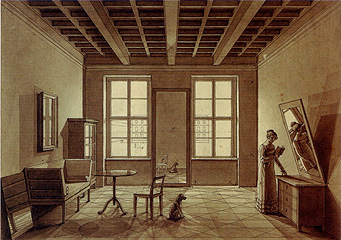 |
|||||||||||||||||||||||||||||||||||||||||||||||||||
|
Johann Erdmann Hummel: Sheet of Studies, 1820 |
|||||||||||||||||||||||||||||||||||||||||||||||||||
| Just as “Freye Perspektive” in no way meant freedom from perspective, Lambert’s “photometry” – his actual invention in the field of optics –did not question the geometric model. On the contrary, photometry was an endeavour to calculate and compensate for the light-related deviations that occur within that model. | |||||||||||||||||||||||||||||||||||||||||||||||||||
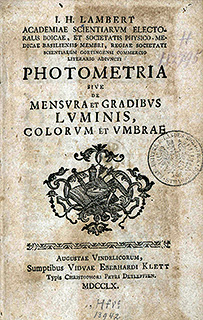 |
|||||||||||||||||||||||||||||||||||||||||||||||||||
|
Johann Heinrich Lambert: Photometria, Augsburg, 1760 |
|||||||||||||||||||||||||||||||||||||||||||||||||||
| Yet until the day when, “similar to a thermometer, […] a photometer”[43] would be invented, the measurement of light would have to rely on the comparative observation of light intensities – and thus remain susceptible to a wide range of errors. The aim was nevertheless clear; it consisted in introducing the same mathematical precision to the optics of luminous phenomena that existed for the optics of refraction. If both registers – the perspectival sketch and the treatment of light – were mastered, nothing more would stand in the way of a precise construction of reality. | |||||||||||||||||||||||||||||||||||||||||||||||||||
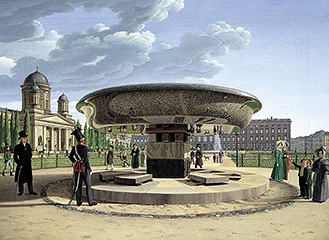 |
|||||||||||||||||||||||||||||||||||||||||||||||||||
|
Johann Erdmann Hummel: The Granite Bowl in the Berlin Lustgarten, 1831 |
|||||||||||||||||||||||||||||||||||||||||||||||||||
| It is not easy, however, to combine exact perspective with a halfway natural impression of light – a fact to which not only the watercolour scene by the aforementioned Hummel testifies, but even present-day computer graphics. Within its Cartesian spatial grid, the latter has problems doing justice to the light effects of any world that does not consist solely of polished surfaces. | |||||||||||||||||||||||||||||||||||||||||||||||||||
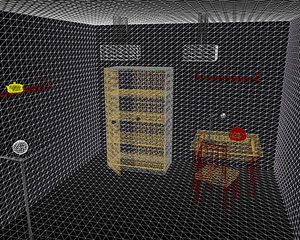 |
|||||||||||||||||||||||||||||||||||||||||||||||||||
|
Room scene, wireframe model, source: http://dudka.cz/rrv/ files/screenshot/ room4-wireframe-divided.png |
|||||||||||||||||||||||||||||||||||||||||||||||||||
| As opposed to “ray tracing”, a vector graphic procedure bearing an affinity to Lambert’s Freye Perspektive, the so-called “radiosity” method represents an attempt to get a handle on the diffuse reflection effects of illuminated surfaces – a concern shared by photometry. What Lambert said about the relationship between the two methods still applies: in comparison to perspectival construction, our ability to capture light effects is “still so far behind that we still cannot explain all of the related visual phenomena, much less predict ones as yet unknown to us”.[44] As Friedrich Kittler has observed, even for the present-day designers of semblances and appearances, photometric radiosity remains a mere “emergency algorithm”: in comparison to ray tracing, it devours “dramatically higher computation times”.[45] | |||||||||||||||||||||||||||||||||||||||||||||||||||
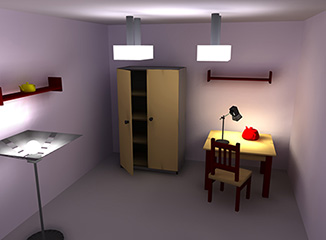 |
|||||||||||||||||||||||||||||||||||||||||||||||||||
|
A scene rendered with the radiosity method, source: http://dudka.cz/ rrv/files/ screenshot/ |
|||||||||||||||||||||||||||||||||||||||||||||||||||
|
In the cases of both photometry and the theory of perspective, the appeal of their mathematization lies above all in the possibility of summarily reversing optical processes. Lambert dreamed of what he called “transcendental optics”,[46] which could construct “truth from the appearance” just as easily as it could, conversely, construct “the appearance from the truth”.[47] Lambert’s mathematical optics was thus not only supposed to enable the calculating brain to construct arbitrary pictorial worlds. It was also – and this would have been its “transcendental”[48] quality – to be capable of exposing the conditions underlying the construction of any image whatsoever. By reversing the perspectival rules governing a given image, for example, it is not difficult to “find the viewpoint of which the artist availed himself”.[49] In the case of photometry, the back-calculation from appearances to the truth is perhaps not quite as simple, but – as we see in Fischer’s analysis of the Munich miracle – it is indeed possible.
For the new “episteme of finitude” whose establishment towards the end of the eighteenth century Foucault described in his Order of Things, Johann Nepomuck Fischer’s optical demonstration provides an early and at the same time consummate example. It almost literally meets the demand that – as expressed by Foucault – “the entire space of the representation should at last be related to one corporeal gaze”.[50] Whereas it did not matter to the geometric model whether the image was projected onto a canvas or a retina, now it was essential to know what takes place in the retina’s crevices, behind the back of the Cartesian subject, as it were. The resulting programme of a “transcendental aesthetic” of sight is also always based on the idea that one need only know the laws of visual appearances in order to reclaim the raw data of perception by means of a kind of “reverse engineering”. Contrary to that hope, however, what is actually triggered by that endeavour is a game without limits. Rather than ending in “the pure transparency of an all-encompassing gaze”[51], the transcendental standpoint causes a continuous fission of perspectives. You never find just one perception; you always have two competing perceptions to deal with: the straightforward look that sees what it sees, and the sidelong glance that envisages the conditions underlying that act of sight. Foucault referred to this figure of a gaze splitting into two axes as the “empirico-transcendental doublet”[52], though to use an expression more common to the times and closer to the science of optics, one could also speak of “Schielen” (“strabismus” or being “cross-eyed”). |
|||||||||||||||||||||||||||||||||||||||||||||||||||
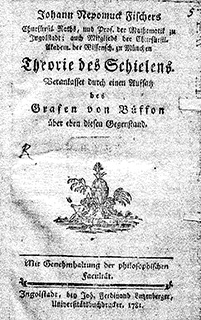 |
|||||||||||||||||||||||||||||||||||||||||||||||||||
|
Johann Nepomuck Fischer: Theorie des Schielens, Ingolstadt 1781 |
|||||||||||||||||||||||||||||||||||||||||||||||||||
|
As chance would have it, the same Fischer who observed the miracle viewers from the side had published a theory of strabismus two years earlier, conceiving of this “so very conspicuous defect”[53] not just as a medical disorder, but also as an aesthetic and moral provocation. The “obliqueness” and “perversity” of the cross-eyed gaze, he proposed, must at the same time be read as a sign of inner “distortion”. As a result, there was no flaw a person should “permit less” in himself than this “betrayer of the heart’s secrets”.[54] What is astonishing is not this “exceedingly disadvantageous interpretation”[55] – which is quite conventional – but rather the fact that it appears in a text claiming to treat the defect as a purely physical one. Perhaps this has something to do with what could be called the epistemological challenge of strabismus. The crossing of the two eyes’ gazes not only forms a living provocation to the camera obscura and its monocular imaging mechanism. To a mind as enlightened as Fischer’s, this condition must have seemed “disturbing” because it represented a kind of derisive repetition of its own epistemological structure. The scientific outlook, which sought to elevate itself, as a higher form of insight, above naïve perception and its deceptions, finds a reflection of its own divisiveness in strabismus. It flip-flops nervously between looking at something as something and the endeavour to see that act of sight itself. The “unpleasant” quality of the cross-eyed condition thus lies partially in the fact that it blatantly exposes the mediacy of the enlightened gaze. Johann Nepomuck Fischer eventually suffered the pitfalls of this doubling of perspectives first-hand. In times of general enlightenment, even the superior perception of the scientist is not immune to sidelong glances revealing it as nothing but run-of-the-mill, imperfect sight. The act of sight that seeks to eliminate the gaze, to avoid being “regarded”, cannot get around occasionally itself being exposed to another’s look. |
|||||||||||||||||||||||||||||||||||||||||||||||||||
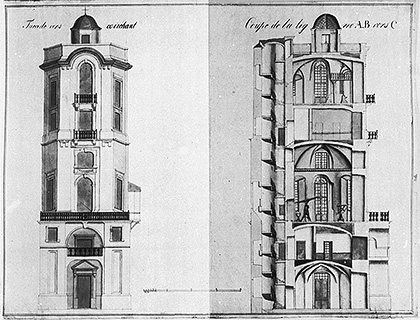 |
|||||||||||||||||||||||||||||||||||||||||||||||||||
|
Andreas Traitteur: Mannheim Observatory, view and vertical section of the tower, 1811 |
|||||||||||||||||||||||||||||||||||||||||||||||||||
|
In 1786, following five years of unemployment, Fischer was appointed court astronomer and director of the observatory in Mannheim. He immediately drew negative attention to himself by proclaiming the observation tower – which had been completed only ten years earlier – entirely useless. The astronomical apparatuses, he complained, picked up even the slightest tremors of the ground and produced imprecise measurements as a result. Speaking to the commission installed to assess the matter, Fischer declared that all of the measuring instruments were worthless except the ones he had invented himself; he could not use the latter, however, because the “wretched tower shakes and sways, and that movement is transmitted to the instruments”.[56] The appraisers, for their part – who tended to sympathize with the tower’s architect – proposed that the trembling of the instruments was not to be attributed “to vibrations of the building, but to a failure to tighten the clamp screws”.[57] The commission ultimately came to a conclusion that reads like a vicious replica of Fischer’s analysis of the Munich miracle. While Fischer had demonstrated to the believers that the change perceived did not take place in the eyes of the Virgin, but in their own eyes, the members of the commission now alleged that the matter of the Mannheim tower’s careening was quite similar in nature. Namely – as set forth in the final report – “the swaying movement is to be found in the body of the astronomer”.[58] Thus in the sidelong view of his contemporaries, the scientist’s transcendental standpoint transforms into a commonplace, empirical look – a look which sways because its master drinks too much, and forgets to tighten the screws as a result. If the story still needs a moral, we can turn to Joseph Anton Weissenbach, a Jesuit priest otherwise not quite as subtle in his critique of the Enlightenment. In 1787 – Fischer was still struggling with the matter of the Mannheim Observatory – Weissenbach addressed the exponents of the new scientific order pointing out that “the light that shows me others always also shows me myself. I cannot have my eyes open for others and close them to what encounters me myself”.[59]
Bibliography: Bexte, Peter: “Denkbilder und andere blinde Flecken. Vom 'Wahr'-Nehmen zum Digitalisieren”. Lecture held at the conference entitled “(Un-)Sichtbares und Medien. Bild - Sprache - Verstehen”, Hattingen 23-25 Oct.2002. Available online at http://www.hattingen.dgbbildungswerk.de/doku/RIC2002/Material/Bexte_hattingen_Main.htm, last checked on 28 Nov. 2003. Crary, Jonathan: Techniken des Betrachters. Sehen und Moderne im 19. Jahrhundert (1990), Dresden and Basel: Vlg. der Kunst, 1996. Cremonini, Andreas: “Über den Glanz. Der Blick als Triebobjekt nach Lacan”, in Claudia Blümle and Anne von der Heiden (eds.): Blickzähmung und Augentäuschung. Zu Jacques Lacans Bildtheorie. Zurich and Berlin: Diaphanes, 2005, pp. 217–48. Dehio, Georg: Handbuch der deutschen Kunstdenkmäler. Munich: Deutscher Kunstverlag, 1996. Fischer, Johann Nepomuck: Theorie des Schielens. Veranlasset durch einen Aufsatz des Grafen von Büffon über eben diesen Gegenstand. Ingolstadt: Lutzenberger, 1781. Fischer, Johann Nepomuck: “Vernünftige Gedanken von der wunderbaren Augenwendung einer Marienbildniß bey St. Peter in München”, in Der beste Nachbar, Sechste Lieferung, 1783. Foucault, Michel: Die Ordnung der Dinge. Eine Archäologie der Humanwissenschaften (1966). Frankfurt am Main: Suhrkamp, 1974. Hanfstaengl, Erika: Die Brüder Cosmas Damian und Egid Quirin Asam. Munich: Deutscher Kunstverlag, 1955. Heidegger, Martin: “Die Zeit des Weltbildes” (1938), in idem: Holzwege. 6th revised edition. Frankfurt am Main: Klostermann, 1980, pp. 73–110. Hernschier, Wolfgang: Ich wollte, ich wäre ein guter Schuhflicker… Das unglückliche Leben des bayerischen Astronomen Johann Nepomuck Fischer (1749-1805). Eine dokumentarische Biographie. Bassum: Verlag für Geschichte der Naturwissenschaften und der Technik, 1997. Kittler, Friedrich: “Computergraphik. Eine halbtechnische Einführung”, 1998. Available online at http://www.hydra.umn.edu/kittler/graphik.html, last checked on 21 Nov. 2007. Kittler, Friedrich A.: Optische Medien. Lecture held in Berlin in 1999. Berlin: Merve, 2002. Kraus, Andreas: Die naturwissenschaftliche Forschung an der Bayerischen Akademie der Wissenschaften im Zeitalter der Aufklärung. Munich: Verlag der Bayerischen Akademie der Wissenschaften / Beck, 1978. Lacan, Jacques: Das Seminar. Book XI: Die vier Grundbegriffe der Psychoanalyse (1964). Weinheim and Berlin: Quadriga, 1987. Lambert, Johann Heinrich: Die freye Perspective oder Anweisung, jeden perspectivischen Aufriß von freyen Stücken und ohne Grundriß zu verfertigen. Zurich: Heidegger & Compagnie, 1759. Lambert, Johann Heinrich: La perspective affranchie de l'embarras du plan géométral. Zürich: Heidegger & Compagnie, 1759. Lambert, Johann Heinrich: Photometria sive de mensura et gradibus luminis, colorum et umbrae. Augusta Vindelicorum: Klett, 1760. Lambert, Johann Heinrich: Neues Organon oder Gedanken über die Erforschung und Bezeichnung des Wahren und dessen Unterscheidung vom Irrthum und Schein. Vol. 2. Leipzig: Wendler, 1764. Lambert, Johann Heinrich: Photometrie (Photometria sive de mensura et gradibus luminis, colorum et umbrae) (1760). Ed. by E. Anding. Leipzig: Engelmann, 1892. Larsen, Erik: L'opera completa di Van Dyck. Milano: Rizzoli, 1980. Milbiller, Joseph and Schmid, Ignaz, (anon.): Wundersame Begebenheit der mirakulosen Augenwendung des gnadenreichen Vesperbildes in der St. Peters Pfarrkirche zu München. Auf Verlangen vieler marianischen Verehrer, und Pflegkinder zum Druck befördert; als ein Schreckbild allen Freygeistern vor Augen gestellt. City of publication not specified (Munich), 1783. Müller-Meiningen, Johanna (ed.): Der blau gestreifte Reiter. Gemälde aus dem Münchner Stadtmuseum. Munich, Wolfratshausen: Münchner Stadtmuseum, Edition Minerva, 2000. Rittershausen, Joseph Sebastian: Die vornehmsten Merkwürdigkeiten der Residenzstadt München für Liebhaber der bildenden Künste. Munich: Lentner, 1787. Sartre, Jean-Paul: Das Sein und das Nichts. Versuch einer phänomenologischen Ontologie (1943). Reinbek bei Hamburg: Rowohlt, 1991. Schmid, Ignaz, (anon.): Eines rechtschaffenen Katholiken unmaßgeblicher Zweifel wider die Wahrheit des in einer jüngst erschienen Schrift behaupteten Mirakels, so sich in der Pfarrkirche zu St. Peter in München ereignet haben soll. City of publication not specified (Munich), 1783. Schmid, Ignaz, (anon.): Urtheil ohne Vorurtheil oder kurze Verfassung der merkwürdigen Umstände jener wunderbaren Begebenheit, welche sich mit dem schmerzhaften Mariä oder sogenannten Vesperbild in St. Peters Pfarr Gotteshaus in München zugetragen hat. City of publication not specified (Munich), 1783. Weissenbach, Joseph Anton: Und das heißt nun aufklären. Ein Versuch von e. unbekannten Verfasser. City of publication not specified, 1787. Wittmann, Reinhard: “Eine bayerische Inquisitionsgeschichte”, in Frédéric Barbier (ed.): Le Livre et l'Historien. Etudes offertes à Henri Jean Martin. Geneva: Droz, 1997, pp. 381–99. Wölfflin, Heinrich: Kunstgeschichtliche Grundbegriffe. Das Problem der Stilentwicklung in der neueren Kunst (1915). 5th edition. Munich: Bruckmann, 1921.
[2] Milbiller and Schmid (anon.) 1783 Wundersame Begebenheit, n.p. [3] Schmid (anon.) 1783 Urtheil ohne Vorurtheil, p. 9. [4] Ibid. [5] See Müller-Meiningen (ed.) 2000 Der blau gestreifte Reiter, p. 100. I viewed a number of them – approximately fifteen engravings – in the Stadtmuseum’s graphics collection, including some in which the painting can be recognized to an extent, but also some which merely convey a scene which is similar from the point of view of content. A number of the works are very clumsy drawings which may not have been executed on site at all, but from memory. It is remarkable that none of the depictions endeavours to reproduce the turn of the eyes; they are merely more or less faithful copies of the altarpiece. [6] The painting (ca. 1628) was already copied frequently during van Dyck’s lifetime, and circulated in engraved reproductions as well (see Larsen 1980 L'opera completa di Van Dyck, p. 98). [7] On Johann de Pay (1600–1660), see Müller-Meiningen (ed.) 2000 Der blau gestreifte Reiter, p. 100. [8] Rittershausen 1787 Die vornehmsten Merkwürdigkeiten, p. 140. [9] Schmid (anon.) 1783 Urtheil ohne Vorurtheil, p. 5. [10] Ibid., p. 6. [11] Ibid., p. 12. [12] Ibid. [13] See Dehio 1996 Handbuch der deutschen Kunstdenkmäler, S. 84 f. and Hanfstaengl 1955 Die Brüder Asam, pp. 49-58. [14] Schmid (anon.) 1783 Eines rechtschaffenen Katholiken..., p. 11. [15] Ibid. [16] Ibid. [17] Wölfflin 1915/1921 Kunstgeschichtliche Grundbegriffe, p. 247. [18] Sartre 1943/1991 Das Sein und das Nichts, p. 466. Here quoted from Jean Paul Sartre, Being and Nothingness: An Essay on Phenomenological Ontology, translated by Hazel E. Barnes (New York, 1956), p. 258.. [19] Lacan 1964/1987 Das Seminar, Book XI, p. 109. Here quoted from Jacques Lacan: The Seminar, Book XI, translated by Alan Sheridan (New York and London, 1978), p. 103. [20] Ibid., pp. 115f. Translator’s note: In the discussion of this quotation, the author emphasizes that “regard” is meant here in both senses of the word: “to look at / to observe” on the one hand, and “to relate or refer to / to concern” on the other. [21] Schmid (anon.) 1783 Eines rechtschaffenen Katholiken..., p. 7. [22] Ibid. [23] See Lacan 1964/1987 Das Seminar. Book XI, p. 100. Here quoted from Lacan 1978 (see note 19), p. 94. [24] Ibid., p. 102. [25] Ibid., p. 113. [26] On this point, see Cremonini 2005 “Über den Glanz”. [27] Lacan 1964/1987 Das Seminar. Book XI, p. 103. Here quoted from Lacan 1978 (see note 19), p. 96. [28] Heidegger 1938/1980 “Die Zeit des Weltbildes”, p. 8. [29] Lacan 1964/1987 Das Seminar. Book XI, p. 59. [30] Heidegger 1938/1980 “Die Zeit des Weltbildes”, p. 106. Here quoted from Martin Heidegger, The Question Concerning Technology and Other Essays, translated by William Lovitt (New York and London, 1977), p. 149. [31] See Hernschier 1997 Ich wollte, ich wäre…, pp. 28–31. [32] See Kraus 1978 Die naturwissenschaftliche Forschung, p. 67. [33] Fischer 1783 “Vernünftige Gedanken”, p. 34. [34] Ibid., p. 37. [35] Ibid., p. 54. [36] 36 See Lambert 1760 Photometria.. [37] Fischer 1783 “Vernünftige Gedanken”, pp. 40f. [38] Ibid., p. 42. [39] Ibid., p. 48. [40] Ibid., p. 56. [41] See Crary 1990/1996 Techniken des Betrachters, p. 43: “At the beginning of the nineteenth century, the camera obscura image is suddenly no longer thought of as an image corresponding to reality. Such claims, previously repeated with regularity, now cease abruptly.” [Author’s emphases.] [42] See Lambert 1759 Die freye Perspective. [43] Lambert 1760/1892 Photometrie, p. 6. [44] Lambert 1764 Neues Organon. Volume 2, p. 258. [45] Kittler 1998 “Computergraphik”, n.p. [46] Lambert 1764 Neues Organon. Volume 2, p. 421. [47] Ibid. [48] See Kittler 2002 Optische Medien, p. 22: “Kant, Lambert’s younger friend and pupil, needed only to go and generalize this transcendental optics’; the result has since been referred to as transcendental philosophy.” [49] Lambert 1759 La perspective affranchie, p. 168. [50] Foucault 1966/1974 Die Ordnung der Dinge, p. 377. [51] Bexte 2002 Denkbilder, n.P. [52] Foucault 1966/1974 Die Ordnung der Dinge, p. 389; see ibid., p. 384: “Man, in the analytic of finitude, is a strange empirico-transcendental doublet, since he is a being such that knowledge will be attained in him of what renders all knowledge possible”. Here quoted from Michel Foucault, The Order of Things: An Archaeology of the Human Sciences (Bristol, 1982), p. 318. [53] Fischer 1781 Theorie des Schielens, p. 6. [54] Ibid., p. 5. [55] Ibid. [56] Hernschier 1997 Ich wollte, ich wäre…, p. 44. [57] Ibid. [58] Quoted in ibid. [59] Weissenbach 1787 Und das heißt nun aufklären, p. 48. |
|||||||||||||||||||||||||||||||||||||||||||||||||||